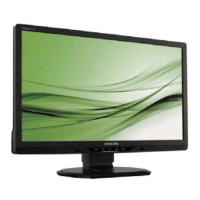
Do you have a question about the Philips 220BL2CB/00 and is the answer not in the manual?
Precautions for laser components, emphasizing beam avoidance.
Emphasizes using only original manufacturer's replacement parts for product reliability.
Guidelines for safely handling the LCD module to prevent damage.
Pin assignments for D-Sub connector, detailing signal connections.
Pin assignments for DVI-D connector, listing signal descriptions.
Identifies front panel controls and features of the monitor.
Step-by-step instructions for connecting the monitor to a computer.
Lists common issues like no picture or AUTO button failure with basic solutions.
Addresses issues like image centering, vibration, flicker, and distortion.
Explains the purpose and functionality of the OSD.
How to navigate and use the OSD menu with control buttons.
Instructions to enter the factory mode for advanced adjustments.
Categorizes and describes bright and dark pixel defects.
Lists acceptable defect levels for different pixel defect types.
Steps and materials needed before starting monitor disassembly.
Detailed steps for disassembling specific monitor parts with notes.
Details D-Sub and DVI-D signal types and characteristics.
Lists factory preset modes and their corresponding timing requirements.
Identifies the specific hardware tool (PCM code) for DDC operations.
Process for re-programming DDC data and serial numbers.
System requirements and steps for using the PI-EDID software.
Details the software used for firmware writing.
Records changes and updates made to the product specification over time.
Describes the Smart Image feature and its profiles.
General cautions and procedures for handling and soldering surface-mounted devices.
Flowchart for diagnosing and resolving no display issues.
Instructions and requirements for performing Hi-Pot electrical safety testing.
